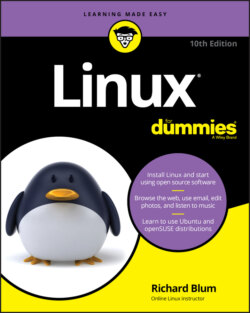Читать книгу Linux For Dummies - Richard Blum - Страница 16
GNU who?
ОглавлениеImagine — software created out of need rather than projected profit. Even though UNIX ultimately became expensive proprietary software, the ideas and motives for its creation were originally based on practical needs. What people usually refer to (in the singular) as the Linux operating system is actually a collection of software tools that were created with the express purpose of solving specific computing problems.
The speed of Linux's popularity also wouldn’t be possible without the vision of a man whom Steven Levy (author of the book Hackers) refers to as “The Last of the Great MIT AI-LAB Hackers” — in the original sense of the word hacker is someone who is an expert at coding, not the current popular meaning that implies criminal intent. This pioneer and advocate of freedom software is Richard Stallman.
The Massachusetts Institute of Technology (MIT) has long held a reputation for nurturing the greatest minds in the technological disciplines. In 1984, Stallman, a gifted student and brilliant programmer at MIT, was faced with a dilemma — sell his talent to a company for a tidy sum of money or donate his gifts to the world. He did what we’d all do … right?
Stallman set out on a journey to create a completely free operating system that he would donate to the world. He understands — and continues to live — the original hacker ethic, which declares that information wants to be free. This concept wasn’t new in his time. In the early days of the computing industry, many advancements were made by freely sharing ideas and programming code. Manufacturer-sponsored user groups brought the best minds together to solve complicated problems. This ethic, Stallman felt, was lost when companies began to hoard software as their own intellectual property with the single purpose of profit.
As you may or may not have gathered by this point, widespread and accessible source code is paramount to successful software development. Source code is the term for the human-readable text (as opposed to the unreadable cyber-hieroglyphics in an “executable” file) that a programmer types to communicate instructions to the computer.
Writing computer programs using code that computers can run directly is an extremely arduous task. Modern computer software is usually written in a human-friendly language and then compiled, or translated, into the computer’s native instruction set. To make changes to this software, a programmer needs access to a program’s source code. Most proprietary software comes only as a precompiled product; the software developer keeps the source code for those programs under lock and key.
After determining that his operating system would be built around the conceptual framework of UNIX, Stallman wanted the project name to distinguish his system from UNIX. So, he chose the recursive acronym GNU (pronounced ga-new), which means GNUs not Unix.
To finance the GNU project, Stallman organized the Free Software Foundation (FSF), which sold open source software to help feed the programmers who worked on its continuing development. (Remember, we’re talking free as in freedom, not free lunch.) Although this organization and goal of creating a complete operating system was necessary and important, a much more important piece of the puzzle had to be put into place to protect this new software from big-business pirates — a concern still all too relevant today as a former Linux company tries to hijack ownership of decades of volunteer work from thousands of people around the world.
The GNU General Public License (GPL) is a unique and creative software license that uses copyright law to protect the freedom of the software user, which is usually the opposite of how a copyright works. Generally, a copyright is an enforceable designation of ownership and restriction from duplication by anyone but the copyright holder. When software is licensed under the GPL, recipients are bound by copyright law to respect the freedom of anyone else to use the software in any way they choose. Software licensed with the GPL is also known as copyleft software (the reverse of right, get it?). Another way to remember the GPL is through its ultimate result: Guaranteed Public for Life.
While Stallman's work set the stage for Linux's rapid climb to popularity, the operating system he and his crew were working on took longer than expected. If you're interested in the completed version, go to www.gnu.org/software/hurd/hurd.html.
